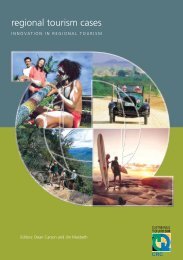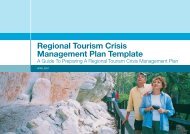Tourism Risk Management - Sustainable Tourism Online
Tourism Risk Management - Sustainable Tourism Online
Tourism Risk Management - Sustainable Tourism Online
Create successful ePaper yourself
Turn your PDF publications into a flip-book with our unique Google optimized e-Paper software.
Establish and maintain regular monitoring and review of:<br />
• decisions and decision-making processes;<br />
• expectations and attitudes;<br />
• new sources of risk;<br />
• risk ratings and priorities of existing hazards;<br />
• allocation of risk ratings and priorities to newly identified hazards;<br />
• elements at risk;<br />
• implementation of existing risk treatment measures;<br />
• additional risk treatment measures to be implemented;<br />
• responsibilities for implementation; and<br />
• timelines for each stage and project completion.<br />
Continue communication and consultation with stakeholders on progress of risk treatment<br />
implementation.<br />
Residual risk<br />
Not all crises can be avoided or prevented.<br />
No matter how effective tourism risk management processes are, crises and disasters will still impact<br />
upon destinations and the tourism facilities within them. The tourism industry has learned to its<br />
considerable cost that even the possibility of a biological disaster (pandemic) is sufficient to cause a<br />
crisis in the industry. The Queensland Government, Australia (2002) has identified that certain events<br />
may trigger or magnify other factors; for example, increases in the cost of public liability insurance for<br />
tourism operators as a result of the September 11 terrorist attacks in New York.<br />
Residual risk is the term given to the risk remaining after the implementation of risk treatment<br />
measures. The treatment of residual risk is to develop plans to respond to and recover from crises<br />
and disasters.<br />
<strong>Tourism</strong> should develop risk management plans and also contribute to multi-agency community<br />
disaster plans.<br />
Chapter Summary<br />
This chapter considers the key elements of crises and disasters and their effects upon<br />
businesses/organizations and destinations, and identifies the role of the tourism industry in risk<br />
management. The chapter provides a practical framework within which tourism destinations and<br />
businesses/organizations can identify, analyse, evaluate, treat, monitor and review risks and<br />
identifies the critical role of the tourism industry in contributing to the development and<br />
implementation of multi-agency disaster management plans and systems.<br />
32 <strong>Tourism</strong> <strong>Risk</strong> <strong>Management</strong> – An Authoritative Guide to Managing Crises in <strong>Tourism</strong>
















